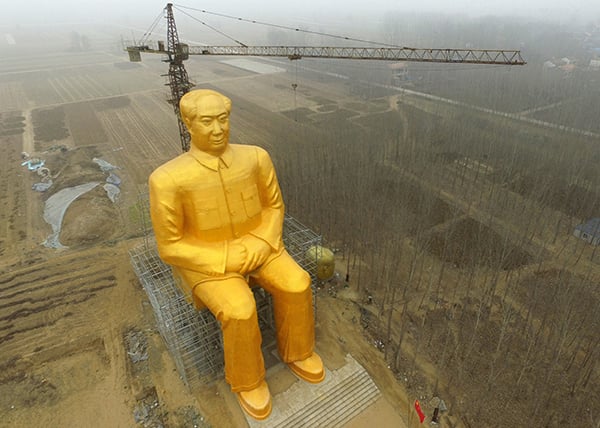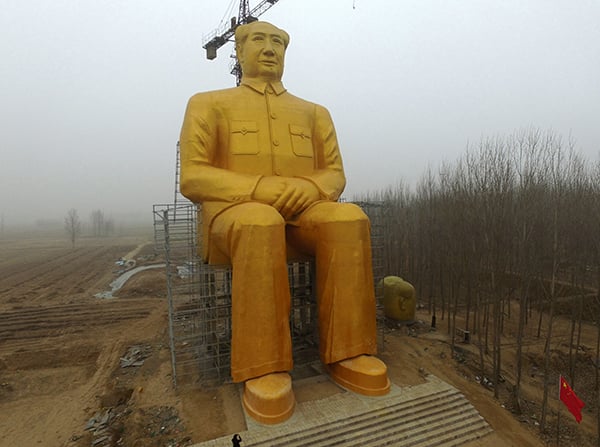Art World
Public Confounded as Chinese Entrepreneurs Erect Ghastly, Giant Mao Zedong Statue
The statue took nine months to complete and cost roughly half a million dollars.

The statue took nine months to complete and cost roughly half a million dollars.

Cait Munro


This photo taken on January 4, 2016 shows a huge statue of Chairman Mao Zedong under construction in Tongxu county in Kaifeng, central China’s Henan province. The statue reportedly measures 120 feet (36.6meters) in height and is located in Zhushigang village.
Photo: STR/AFP/Getty Images.
A towering, gold-toned statue of communist leader Mao Zedong has been erected in the rural fields of China’s impoverished Henan province by a group of anonymous local entrepreneurs who reportedly funded the project for three million yuan ($460,000). The statue has prompted onlookers around the world to question why anyone would want to memorialize such a controversial figure.
Mao ruled China for nearly three decades, from 1949 until his death in 1976, during which time he is widely believed to have caused the deaths of between 40 and 70 million people by famine, forced labor, and executions. On the world stage, he is most often compared to dictators Adolf Hitler and Joseph Stalin, but in China, where communist leadership still controls public discussions of Chinese history and politics, he is viewed by some as an admirable leader.
Tongxu village in Henan province, where the statue sits, was at the epicenter of the famine that killed millions in the 1950s and early ’60s as a result of Mao’s so-called “Great Leap Forward” toward modernization in China. The statue is approximately 37 meteres (121 feet) tall, and took the local farmers and villagers over nine months to complete. While Mao’s body is finished, the chair upon which he will sit is still under construction. Strangely, a disembodied replica of the statue’s head sits beside it on one side.

This photo taken on January 4, 2016 shows a huge statue of Chairman Mao Zedong under construction in Tongxu county in Kaifeng, central China’s Henan province. The statue reportedly measures 120 feet (36.6meters) in height and is located in Zhushigang village.
Photo: STR/AFP/Getty Images.
Liu Jianwu, dean of China’s Mao Zedong research center (who did not have a hand in the erection of the statue), told the Guardian that is appears to have been built to “commemorate a leader.”
“In contemporary China, Mao Zedong represents the embodiment of fairness and justice,” Liu said. “In the hearts of ordinary people, Mao represents fairness and justice. So people hold these kinds of emotions towards him.”
Professor Michel Hockx, Director of the SOAS China Institute at the University of London, sees it as more of an act of nostalgia than reverence: “There has been an enormous amount of Mao nostalgia for at least a decade already, if not longer. Memorabilia from the 1950s and 1960s (Mao badges, little red books) are on sale everywhere and popular not only with local Chinese but also with tourists,” he told the Telegraph.
The statue—not to mention how much it cost to build—has faced widespread criticism on international media outlets, Twitter, Facebook, and Sina Weibo. The entrepreneurs responsible for the statue have yet to speak out.
“How about using the money for poverty alleviation first?” said one Sina Weibo commenter. “Besides, it’s so ugly—doesn’t look a bit like [Mao].”